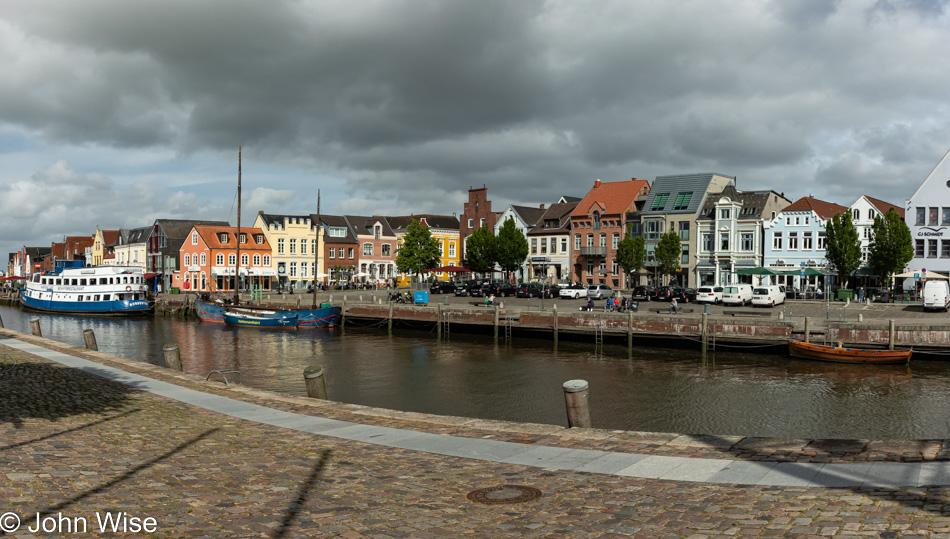
We are ready for our e-bike adventure to the Westerhever Leuchtturm (Lighthouse), and while it’s still as cold as yesterday, the patches of blue sky hold great promise. For some crazy reason, our hotel doesn’t start bike rentals until 9:00 a.m. or almost 5 hours into the day after the sun has started rising. The 29 Euro price for the entire day is pretty good when you consider that e-bikes in Germany of the quality we’ll be riding today cost between $3,300 and $4,300.
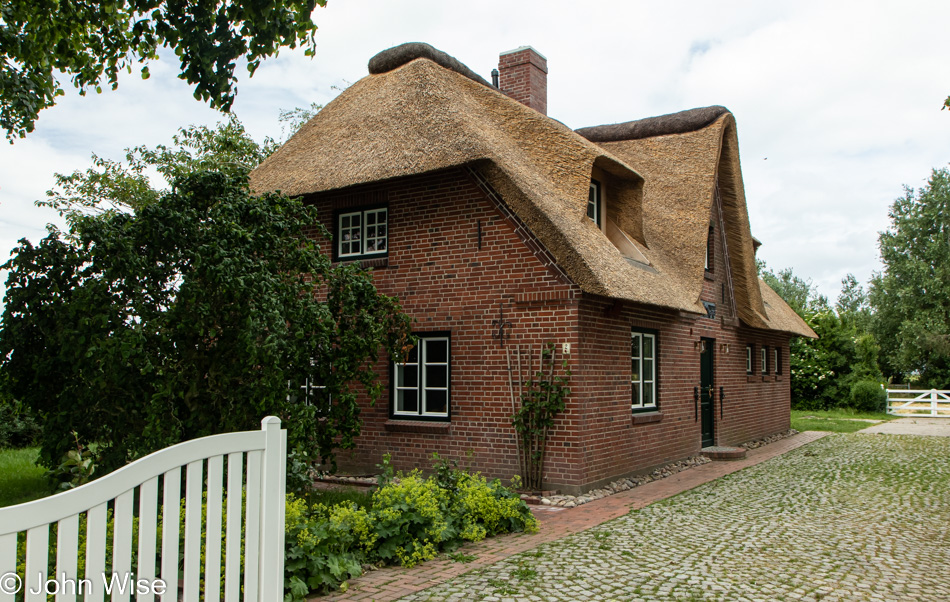
It was already 10:00 when we left Husum and entered the countryside. We pass many examples of these Frisian homes with their distinct thatched roofs, but photographing them isn’t always easy because they are often built right next to the street and have fences so close to the front of the house that getting an uninterrupted view is a challenge. Maybe this is a good thing; otherwise, I might turn the day into an architectural study of these unique historic homes.
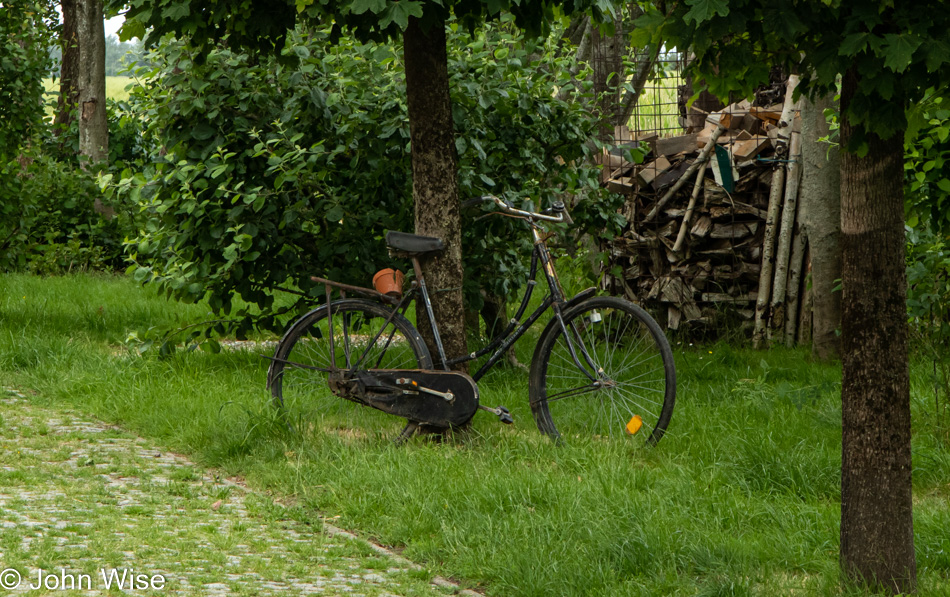
This is not an example of our Riese und Müller e-bike, but it is a fine specimen of a very old bicycle. Our bikes today have a top speed of 35 km/h or 22mph, with the battery conveniently mounted over the back wheel. Klaus pointed out that our bikes are made just outside of Frankfurt in Darmstadt, so maybe he has some local pride about that. As we have 80 kilometers (50 miles) to cover today, we are in Eco mode, which is the lowest electric assist there is, with Tour, Sport, and Turbo remaining untested until we determine how the battery is performing. The Nordsee-Hotel Hinrichsen, where we are staying, supplied us with the bikes and also included the charging unit should we need to charge the battery down the road. Not only that, they gave us a phone number we could call if we had a bike failure so we could get a lift back to town.
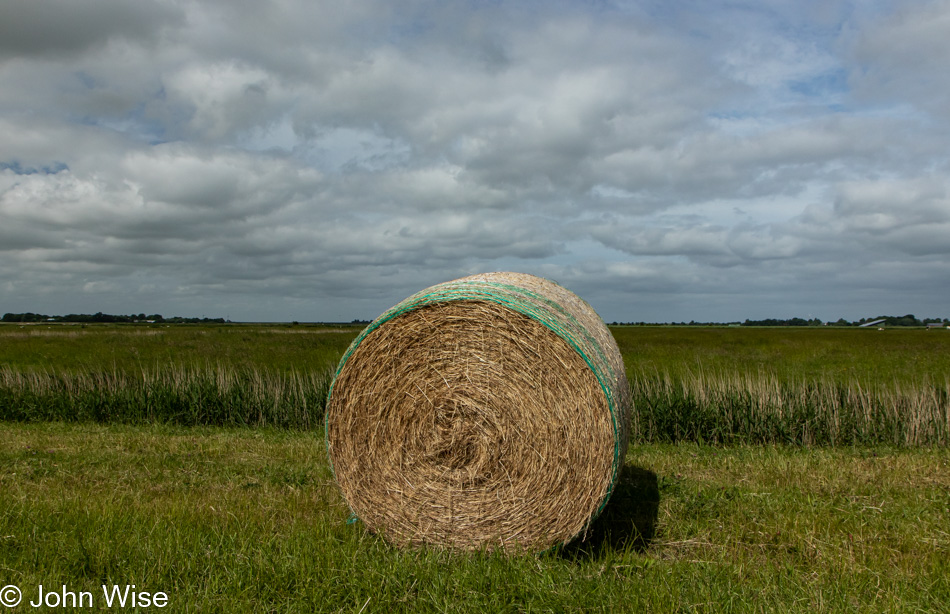
Windmills and farms, dikes and sheep, clouds and wind, with those things, you have the Wattenmeer. If you time things just right, you may never see the sea out on these flatlands.
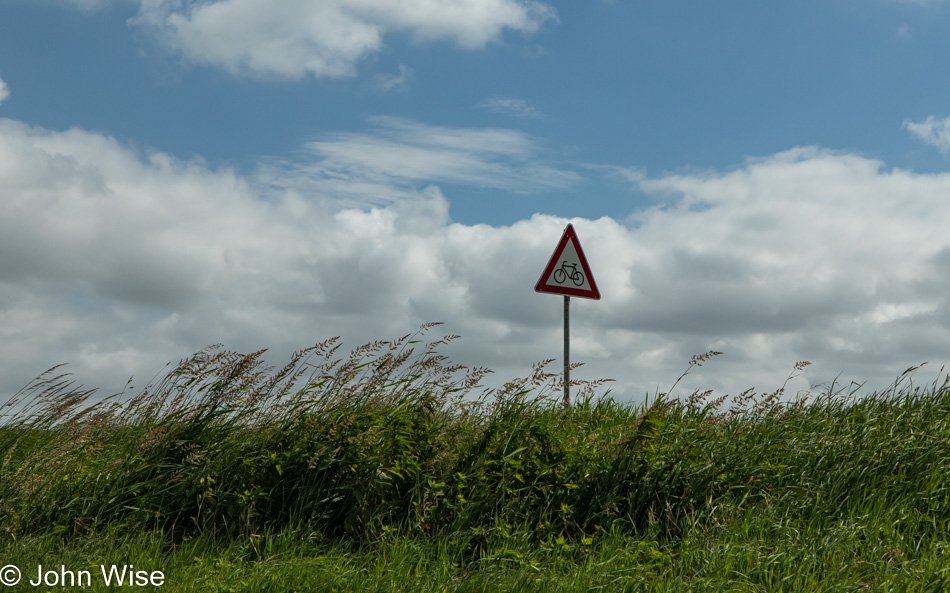
This environment is incredibly kind to bikers, well, for at least half the year, as I might be leery about the narrow roads in winter. In many cases, the roads have bike lanes that run parallel to the main road and far enough away to not be threatening. There will be times you have to share the streets with cars, and where I said these roads were narrow, I’m saying that cars have to pull over to let another car pass, so when a bike is on the road, they go to the far left. Fortunately, German drivers are extremely well-trained and mostly observe the rules.
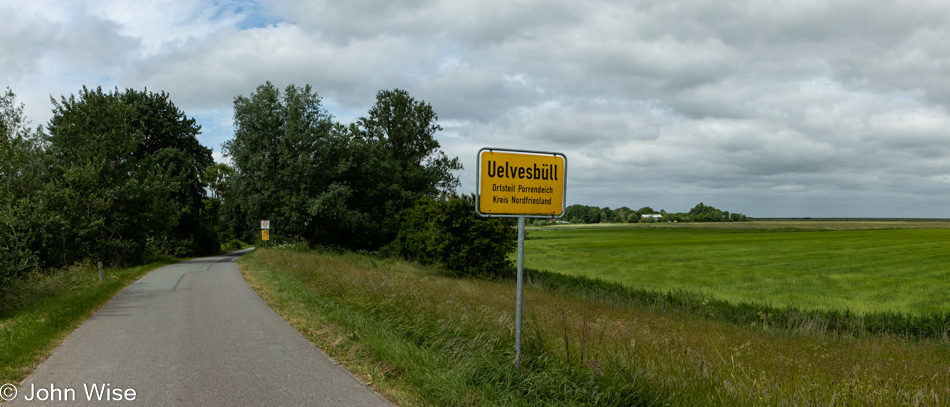
Google Maps has many ideas of roadways that could cross this landscape. You have to do some pathfinding and zoom in on satellite maps, trying to find out if the other side of a dike is paved or just falls off into the sea. Well, not really the sea, but a massive mudflat (at least when the tide is out). By the way, this is not a bike trail but a street shared with the occasional driver.
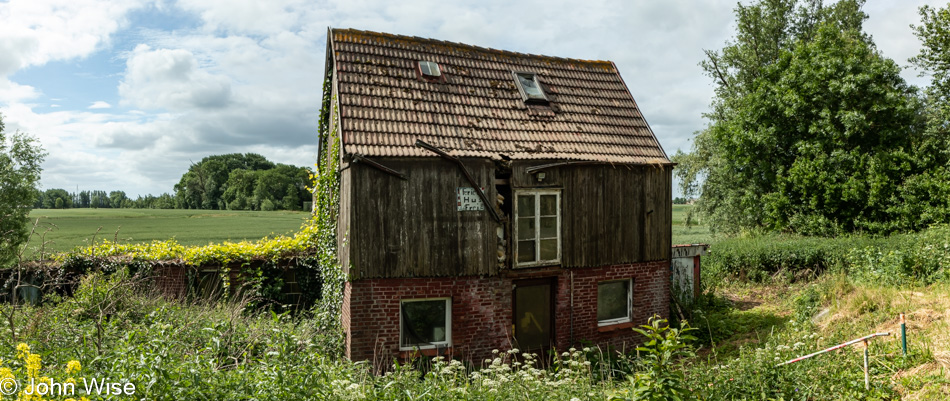
While you can’t see it in this image, the sign on the front of the house is offering this as a vacation rental; I’m pretty sure that’s a joke.

I’ll take one in electric, please? The Citroën 2CV (Deux Chevaux or two horses) is a classic French car and was the answer to the Volkswagen beetle, and yes, I really would like one of these as an electric model. This or the amazing Citroën DS.

These damned northerners are Lutherans, and unlike the Bavarians, who are Catholics, with churches open every day of the week, the Lutherans and Protestants only believe in church on Sunday. Nothing like serious guilt to push people into needing a church at any time of day or night. Hmmm, this makes me wonder if synagogues are open 24/7.
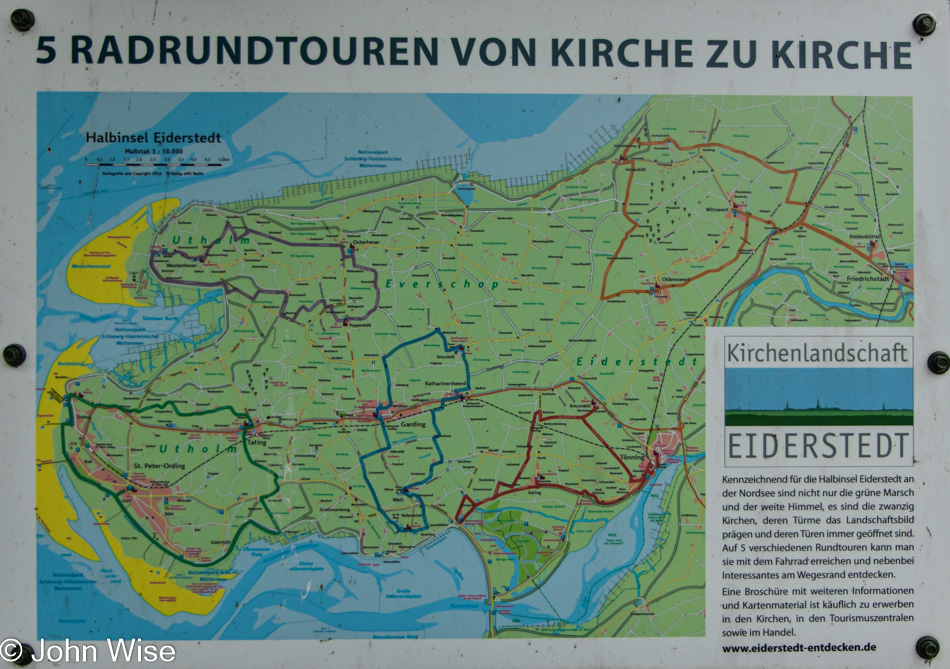
Well, at least they have church tours available for bikers, but when are they open? That’s right, five church tours out on this 30-kilometer-long piece of land. As for the church, I couldn’t enter, it is the St. Nikolai Kirche.
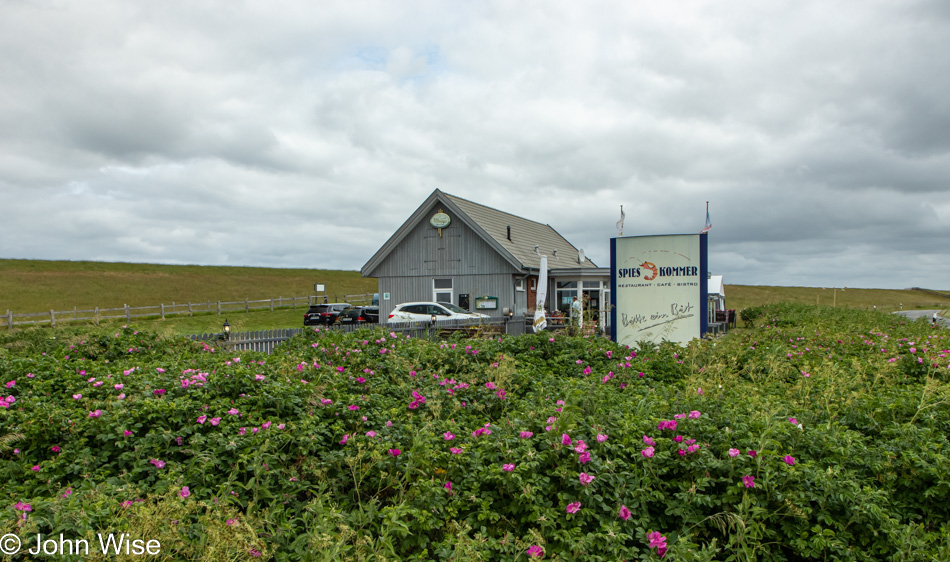
Out in the middle of nowhere is a place called Tetenbüll, and with nothing around us besides the ubiquitous sheep, there is this small restaurant called Spieskommer. In the bike parking lot are more than a dozen of us, if only they had bike recharging facilities. This was a great stop as we are more than 20 kilometers (12 miles) from Husum, and I had anticipated more of these little stands, so I didn’t bring water. This turned out to be a nice little stop for lunch, and if you are thinking that this seems early for lunch, well, it took us 2 hours to get here.
Whoa, you two are only going twice the speed of walking, and you are on e-bikes? We both carry DSLR cameras, and while this might look like the 10th stop if you were counting the photos above, there were at least twice that in between where we stopped for photos Klaus wanted, photos I took I didn’t like, and verifying we were still going in the right direction.
With coffee, water, a fish sandwich, and a salami and cheese sandwich to refuel us, we were again on our way.

But not for long. Well, this is a first for me: a Milk Station, not a gas station, but a place to pump milk.

No joke, there’s self-serve milk on demand and a vending machine with eggs, beer (no I.D. required), juice, cereal, salami, and other stuff right there in this Holstein-painted hut. Look in the background of both photos, and you’ll see the barns where the milk comes from (Note to Caroline: Yeah, I know milk comes from cows, but those cows are in the barn, so give me a break).
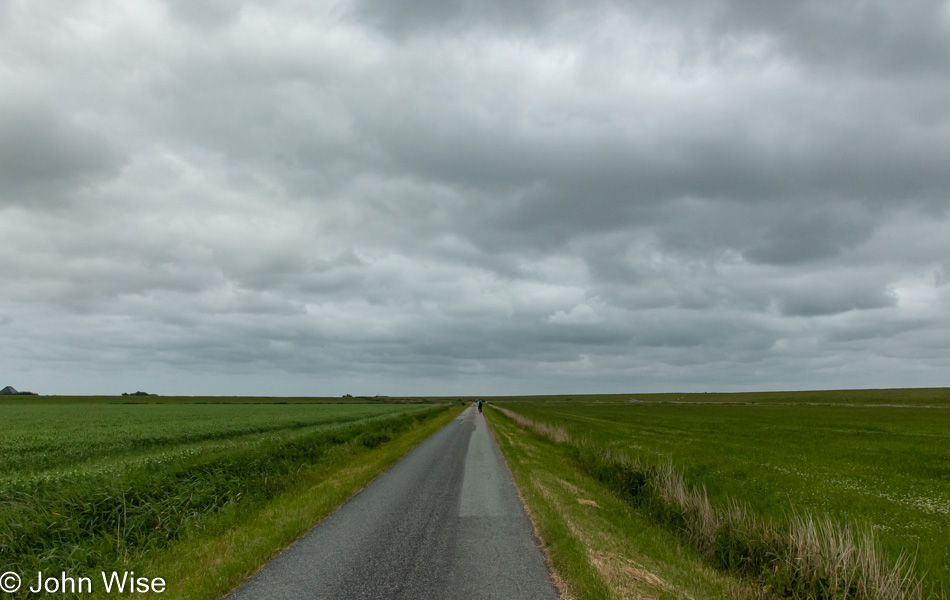
Maybe we didn’t really need e-bikes in the first place, as this land is so flat, but when the wind howls, that extra power is super helpful. We only felt a couple of raindrops out here; seriously, only one or two tiny ones, but it was enough to send a prayer back to St. Nikolai Church in Uelvesbüll that we wouldn’t see rain. Oh, I forgot to add a detail regarding the cold: I don’t have a jacket or sweater with me, and there was no way I was going to wear that 6-pound raincoat while out on a ride either.

To walk on the Watt is to live, but what is a Watt? The Watt of “Wattenmeer” is translated as mudflat. And while I was up here nearly frozen, windburned, and getting sunburned without the sun, there was a family of six (three are out of frame) walking barefoot out in the mud.
Maybe this is a good time to explain the Wadden Sea (Wattenmeer in German) that stretches from the Netherlands past Germany and into Denmark. It is the world’s largest tidal flat and one of the two most important vacation destinations for Germans. The island of Sylt, which is north of us, is acclaimed for its natural beauty, but it’s also derided as being a destination for snooty, wealthy Germans that the larger part of the German population hates or at least dislikes.

Speaking of likes and dislikes, Germans love rules, their cars, others not talking to them, and expensive things. They don’t like rule breakers, conspicuous consumption, foreigners (unless they are tourists who go home), and ice cold drinks. As for me, I love laws but find silly rules that press too deeply into conformity here in Germany silly. I’m now old enough not to care about cars, I like cheap things, foreigners are great as they bring new things to culture and our palates, and I grew up on cold drinks, so those are okay too.
Etepetete is a great word to describe many Germans. What is etepetete? First of all, yes, it sounds kind of like “Ate a potato” to me, with German Wikipedia saying, “Fussy…excessively picky… princess-like behavior.” Well, this describes maybe 80% of the population here in the center of Europe. Hey, wait a second, that sounds like you, John! Yeah, I’ll own that, but Germans can’t see it in themselves, while their form of humility is of an arrogance that rubs me like sandpaper. In this regard, Germans and French are identical in that both feel that their culture and education give them the right to be as etepetete as they want.
But etepetete is NOT arrogance unless you consider intelligence and pride of culture as arrogance. America has its own arrogance found in vulgar strength, weapons, being loud, and dismissing everyone else as weak. Germans and French are rightfully arrogant if you call worldliness and tolerance with a measure of intellectualism thrown in as being etepetete. When so many other places on earth value strength and bloodshed as the hallmarks of civilization, then maybe central Europe would look weak and arrogant behind their peaceful multi-culturalism, but that would be wrong. Refined tastes of the few versus the unrefined maws of the un-enlightened masses might be confused. For those striving for a better world, they shouldn’t be humble as they try to demonstrate a better way. Long live being etepetete.
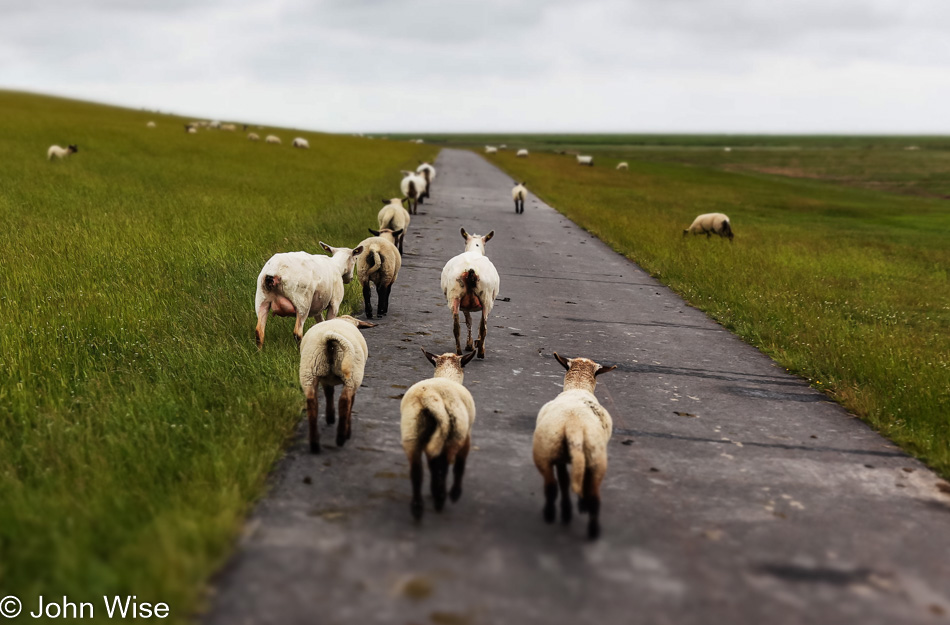
These sheep are heading in the direction of the Westerhever Leuchtturm, a pilgrimage we must all make.

Oh, how I wanted the sun if for no other reason than to be warm on the tiny path along the mudflat, but here we are at the lighthouse, and the heavy clouds lend big drama to the sight.
And the gray of the area also plays well to something Jutta shared with me prior to leaving Frankfurt. It was found in a poem from Theodor Storm about Die graue Stadt am grauen Meer or The Gray Town by the Gray Sea, which told of Storm’s hometown, Husum. It is titled:
The City:
At the grey shore by the grey sea
and apart, lies the city;
mists push down hard on the roofs
and through the quiet the sea booms
uniformly about the city.
No wood murmurs; in May, no bird
chirps without intermission;
only the migrating geese with harsh cries
fly by in the autumn night;
and by the shore the grass ripples.
Yet my heart clings to you,
you grey city by the sea;
forever and forever the magic of youth
will rest smilingly upon you; upon you,
you grey city by the sea.
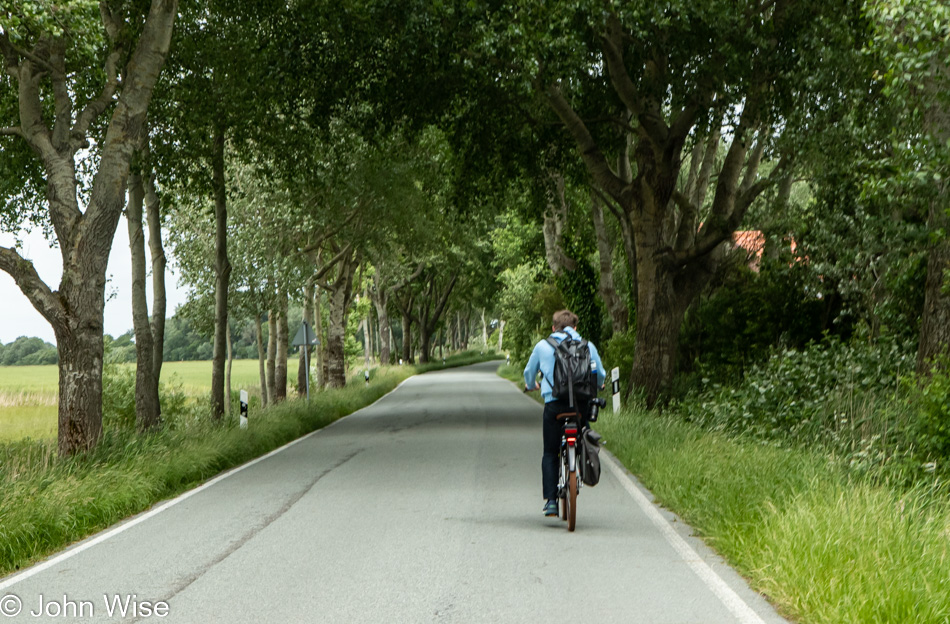
Fifty miles (80 kilometers) just to see the lighthouse by the gray sea under gray skies was a perfect way to spend the day if you were John and Klaus.
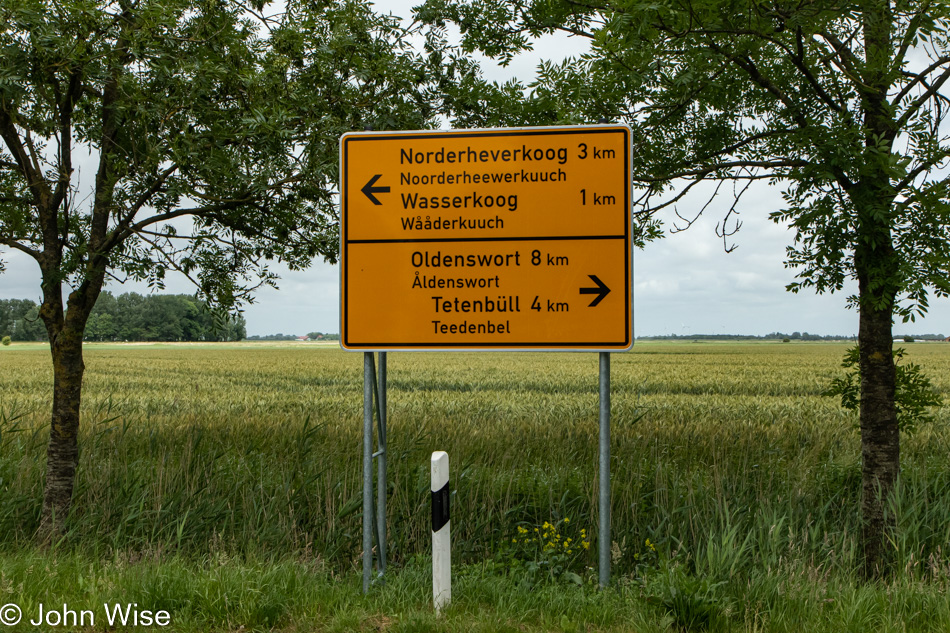
I’d have sworn we had to go left from my internal compass, but obviously, it was malfunctioning as we had to go right. While our route back to Husum was a different one, we made the smart decision to just ride as the lower the sun got in the sky the colder it was getting. Not only was it getting chillier, but it was also growing windier. Why didn’t I bring a sweater when I knew that the temperatures wouldn’t go above 65 degrees? I’ll tell you why: in Arizona, during the winter, when we have many days of 60 – 65 degrees, it’s incredibly nice out, but we don’t have any humidity.
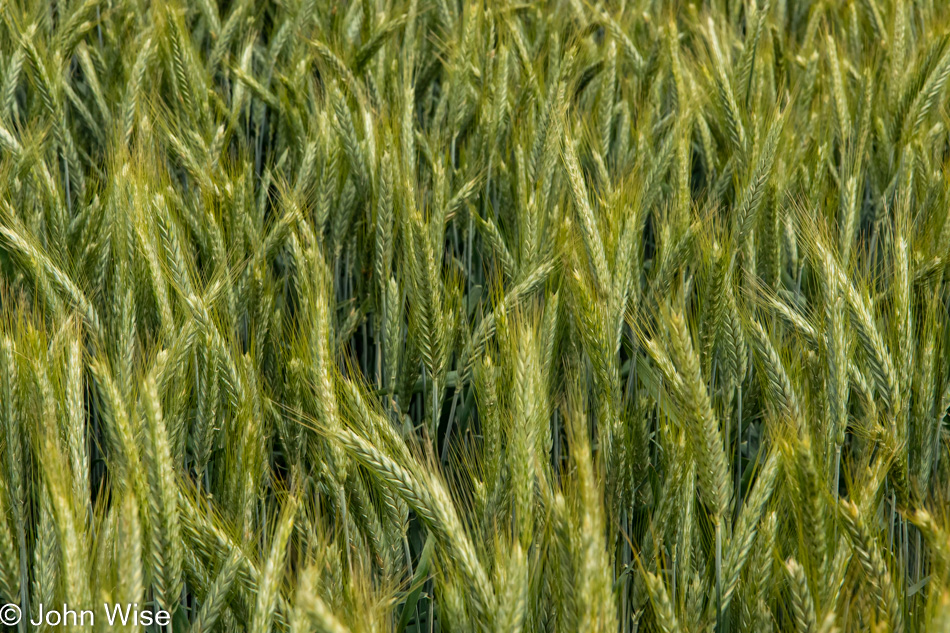
Grain, grasses, sheep, and cows are the main staples found on farms across the region. Most of the pauses taken by this time are chances to let our butts stop hurting for a minute, along with allowing thighs on fire to relax.

Klaus and I are very different people, which should go without saying, seeing he’s German and I’m American, but we do have a few things in common. We are married to the daughters of Jutta Engelhardt; our superpower is finding things for our spouses, we both love being outside, photography, and we both love cooking. Maybe because of the German/American thing, our demeanors are incredibly different. I’m loud in comparison, while Klaus is soft-spoken and often quiet. I volunteer too much and am heavily opinionated, while Klaus must be drawn out and has opinions that seem fixed but could be malleable.
We’ve certainly laughed enough while out on our first brothers-in-law’s trip away from everything, and we’ve enjoyed turning into pescatarians for this journey, learning just a little more about each other. I’d certainly do all of this again, although it would be in a warm and sunny environment, or I’d have the proper clothing. As a matter of fact, I’d love to see Klaus visit me in America where I could take him out on a road trip to the West Coast of America. Ideally, my sister-in-law would overcome some temporary hiccups she’s currently experiencing, and Caroline, Klaus, and I could get out for a visit to some of our favorite sites out our way.

We are nearly back in Husum and need a break. Wow, what a great stop, although the cafe was closed. This old building from 1610 that was a brewery from 1707 to 1850 now serves as a place to refuel when out on bike rides in the area. With the cafe, a nice clean bathroom open 24 hours a day, and an e-bike charging area outback, this is a serious luxury catering to those who choose to pedal through this landscape of northern Germany.